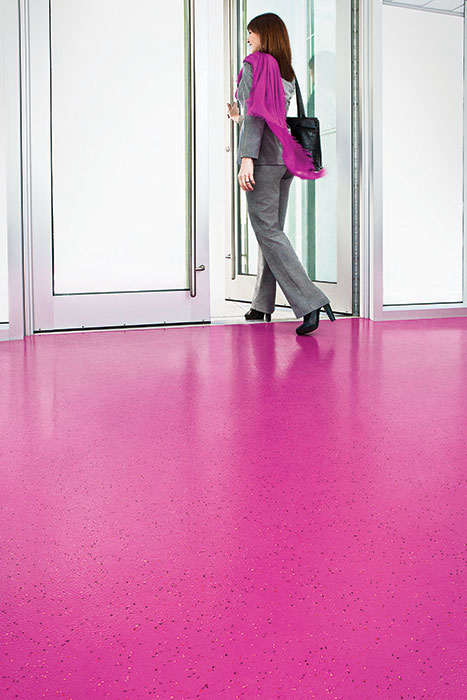Color in Health Care Environments
Flooring and Color in Health Care
One of the primary and most visible places to add color in a health-care setting is on the floor. As part of a total color plan, flooring can make a bold, contrasting color statement or be a neutral or complementary element. Depending on the material selected, the particular hues, values, and chroma of the colors selected can be chosen to produce the intended result.
In order to demonstrate the practical use of color in health-care interiors, rubber flooring can be used as an example of an optimal choice for incorporating color effectively. As a manufactured product, it is available in both tile and sheet flooring. From a color standpoint, it is readily available in a broad range of hues and values with considerable capability to provide very strong color saturations (chroma). As such, it can work with a full variety of color plans. It can also be readily cut and formed to suit different design schemes to create patterns, imagery, wayfinding, etc.

Photo courtesy of American Biltrite
Non-SBR rubber flooring has the ability to provide long-lasting, durable color in high saturation (chroma) levels while still meeting other demands for hygiene, maintenance, and durability.
Most rubber flooring is made from styrene-butadiene rubber (SBR) which has limitations in the amount of color saturation that it can hold initially and its limited resistance to fading over time. At least one manufacturer offers rubber flooring that does not contain SBR. Beyond the color aspects of non-SBR rubber flooring, there are several other important user concerns that designers need to consider in such flooring.
- Safety: Flooring selection must conform to strict safety standards for mobility including the standards outlined in the Americans with Disabilities Act (ADA). In addition to its well-known wheelchair mobility requirements, the ADA also refers to flooring safety against slips and falls. The standard requires flooring to meet a coefficient of friction of 0.5 for flat surfaces and 0.7 for ramped applications, under dry conditions.
- Infection Control: An increased incidence of hospital-acquired infections has made it necessary to select flooring that can be decontaminated by the broadest selection of disinfectants. If there are any doubts about the flooring capability, then installing a small test floor area can determine if the flooring type is suitable for its intended use. When making flooring selections for health care, designers should inquire about the product’s bacterial blocking agents. Flooring such as rubber has natural bacterial suppressers, and now many manufacturers are introducing natural antibacterial additives such as silver.
- Hygiene: Health-care floors must be capable of eliminating any open areas for mold and mildew to grow. Rubber floors that can offer a totally sealed area at the floor and wall intersection, such as built-in cove base systems, flash cove, or integral cove systems, can do this easily. Similarly, selecting floors that do not need regular coats of floor finish to protect them from surface moisture penetration are preferable since the material itself, and not the coatings, help assure better hygiene.
- Maintenance: Look for floors that require low maintenance procedures. Floors that require stripping and waxing on a regular basis just to retain its physical properties as well as protection against moisture penetration are burdens on the facility’s resources. Appropriate flooring for health care must have the capability of being cleaned daily by such methods as auto scrubbing anddamp mopping as well as periodically dry-buffed.
- Durability: Select flooring that has a 15- to20-year lifespan that will not deteriorate from chemicals, disinfectants, or abrasion and can hold up under rolling traffic (i.e., beds and gurneys) per ASTM 925. It should also pass appropriate ASTM requirements for light (UV) stability and static load.
- Comfort: Health-care flooring should offer the highest ergonomic values possible. Consider the use of rubber-based products that are favored for their comfort and sound reducing capabilities—not only for patients, but also for staff.
- Life Cycle and the Return on Investment (ROI): Research has confirmed that the lowest-cost flooring is not the best purchase. Facilities that invest in low-maintenance flooring gain that investment back within a short period of time. Rubber-based flooring routinely demonstrates the highest ROI followed by ceramic.
Properly considering all of the above aspects will help assure that the flooring is appropriate for health-care designs without compromising the visual and color aspects.









